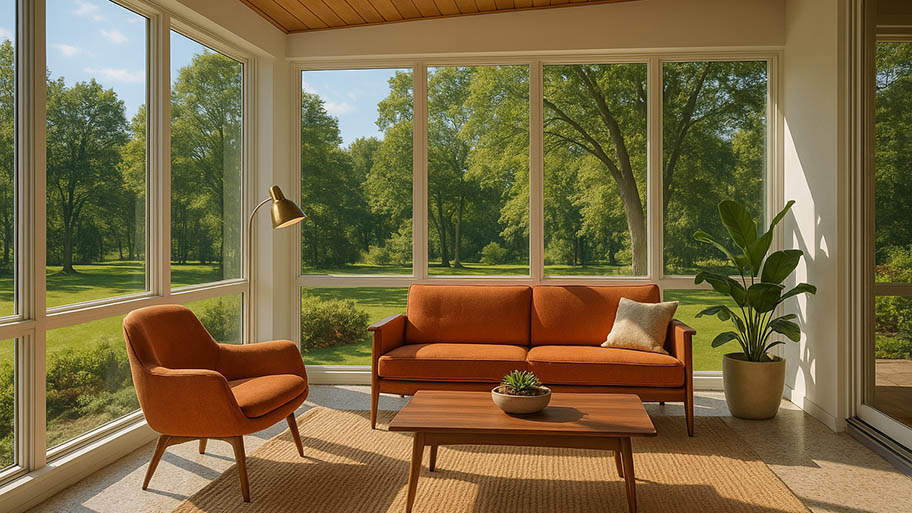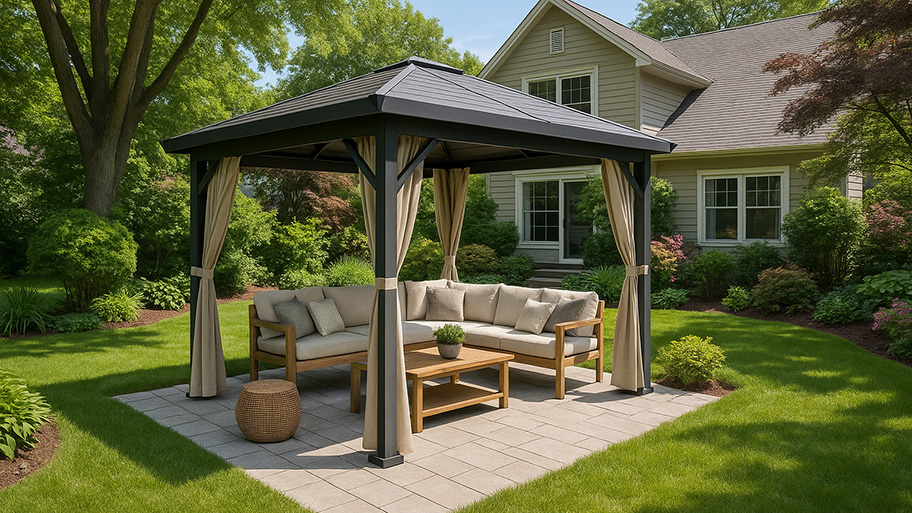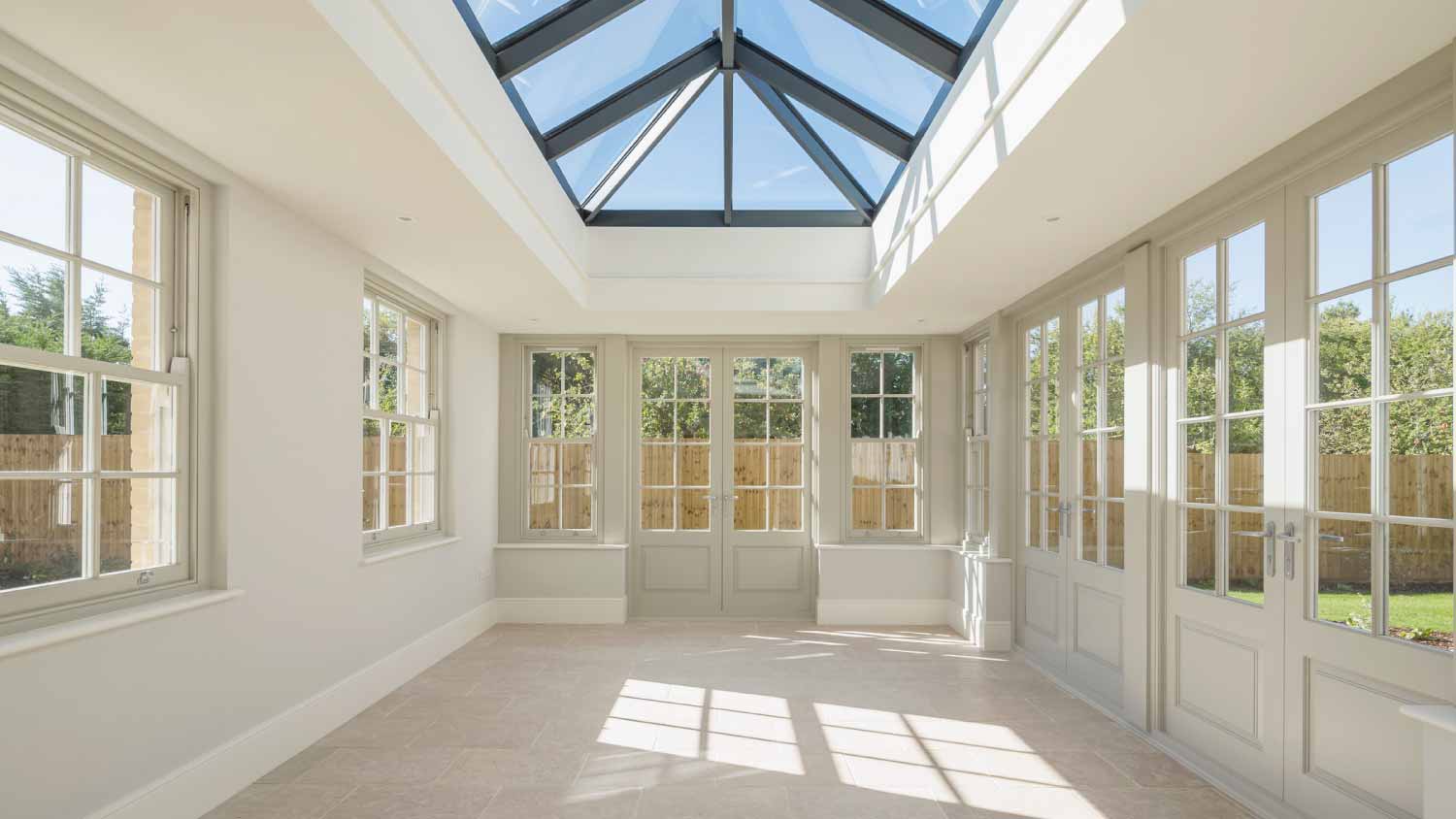
Considering adding a screened porch to your home? Discover the average cost of a screened-in porch, depending on its size, location, and more.
You'll be floored by all of these flooring options for your bright new sunroom


Your new sunroom may be a great place to absorb some summer rays, watch a thunderstorm, or cozy up on a cold day—but are your sunroom floors ready for the same? Choosing the best floors for your sunroom is not just about aesthetics. Similar to mudroom floors, these tiles, planks, and slabs must be able to hold up under direct sunlight, muddy boots, and possibly even freezing temps.
Porcelain and ceramic tiles are popular options for transition rooms for a reason. An endless variety of colors, styles, and configurations can liven up an indoor/outdoor space flushed with sunlight. However, there are differences between the two—and it's important to pair the right one with your sunroom style.
Porcelain tile is fired at a higher temperature and composed of finer grains. It holds up against temperature changes better than ceramic tile and is nearly nonporous enough to protect against water. For this reason, opt for porcelain tiles in three-season sunrooms that don't have insulation and only consider ceramic tiles in four-season sunrooms that have better protection from the cold.
Porcelain tile materials and installation are a bit higher than ceramic tile. In total, you'll pay between $13 and $65 per square foot for porcelain tile. Since the material is more difficult to cut, it's best to leave the installation to the professionals.
Ceramic tiles generally cost less than porcelain tiles, so you may prefer it for a DIY project. You'll pay $3 to $15 to have it professionally installed, but you can trim the price of ceramic tile installation by $2 per square foot by installing it yourself.

Natural stone is the gold standard for patios and porches, so it's no surprise that stone flooring of all types works in sunrooms as well. However, much like ceramic and porcelain tiles, remember that stone will be chilly on the feet, especially in the colder months. That being said, the beauty of your stone options can pull the whole room together.
Natural stone flooring comes in far more options than you may imagine: marble, slate, travertine, and granite are just a few of the available options. Some options, like basalt, are ideal in sunrooms that warm up quickly. Other options, such as granite, are best in high-traffic areas, like a sunroom that sits off the main area of your house.
Stone flooring is available in a vast price range, anywhere from $5 to $35 per square foot. Since installing stone flooring is a bit more complex, particularly because stones often come in unique shapes that require complex placement and adhesion, you may want to consider hiring a professional.
Embrace a cozy, rustic feel in your sunroom by adding iconic hardwood beneath your feet. Not only will hardwood floors potentially extend the style of the rest of your home to the new space, but it will also last for decades.
It goes without saying that hardwood is best for four-season sunrooms that do not experience freezing temperatures or regular wet foot traffic. It's also best to buy a type of hardwood flooring that doesn't fade in the sunlight—or, if it does, it fades into a color you enjoy.
The cost of hardwood flooring is a bit of an investment at $13 to $25 per square foot, but keep in mind you may need an additional seal or stain to protect your hardwood.
Looking for that happy middle ground between a hardwood and a low-maintenance sunroom floor? Engineered wood combines a coated acrylic top layer, a core of hardwood, and several fortifying layers of veneer.
While not immune to the effects of water and temperature changes, engineered wood is a bit tougher than hardwood. And similar to hardwood, it can fade in the sunlight, so it's best to choose a light-colored engineered wood or one that fades to a color that will match your style.
You'll save some cash by choosing an engineered wood flooring over hardwood. These floors cost $2.50 to $10 per square foot. Some brands sell click-and-lock varieties that also allow you to skip the cost of professional installation.

If you take one step beyond engineered hardwood, you get into the vinyl and luxury vinyl categories. Made up of a composite of plastic, vinyl floors can imitate the look of stone, ceramic, or, of course, hardwood. The versatile and easy-to-install option is a favorite for sunrooms that face year-round changes in temperature.
While both types of vinyl flooring are waterproof, luxury vinyl floors (LVF) will last a little longer on average. However, both are resistant to warping, scratches, and dents—all ideal if you use your sunroom as a mudroom as well. You can even use vinyl flooring for a screened-in porch due to its durability.
The price of vinyl is one of the greatest perks of this sunroom flooring option. On average, you'll pay between $2 and $7 per square foot or up to $14 per square foot for luxury options. There are many varieties on the market and a majority are relatively easy to install yourself.
On the fence between laminate and vinyl flooring? Laminate is popular for its low price and ability to mimic more expensive types of flooring. However, it's not best for sunrooms prone to wet shoes, as it's not waterproof like many types of vinyl. On the other hand, you can often install it right on top of a subfloor, making it ideal for building a sunroom on a deck.
The low cost of laminate does come at a long-term price. It can be slippery to walk on, will absorb water over time, and cannot be refinished like engineered hardwood. Laminate is best for building a sunroom on a budget and for four-season sunrooms not used as a mudroom.
Laminate flooring can cost as little as $1 per square foot but range up to $7 on average. You have plenty of DIY options when installing laminate floors, yet again, employing the popular click-and-lock method.
At first thought, the idea of polished concrete floors in your sunroom may sound a bit cold and bland, but they're rising in popularity for a reason. The sleek, modern look of polished concrete can simplify your sunroom design. You can also stain it or stamp it for a custom look.
You probably won't be surprised to hear that concrete floors are very durable. That being said, you will avoid stains, cracks, and dents by sealing and polishing them as well. Concrete floors are ideal for both three- and four-season sunrooms.
Pouring polished concrete floors costs between $2 and $16 per square foot. The wide range in cost accounts for the many finishes available, including a polish that will transform the concrete we know from our driveways into one sleek enough for the indoors. Concrete flooring installation is not a DIY gig, so it's best to call your local sunroom contractors to take care of the work.
From average costs to expert advice, get all the answers you need to get your job done.

Considering adding a screened porch to your home? Discover the average cost of a screened-in porch, depending on its size, location, and more.

When you're ready to kick back and enjoy nature without the bugs, a sunroom is your best option. Learn how much a sunroom addition costs to set your budget.

Homeowners can enclose their porches in a few different ways—each having their own price tag. Learn what contributes to the total cost to enclose a porch and how you can reduce the bill.

A screened-in porch lets you enjoy the outdoors while being protected from bugs and direct sun. Learn the pros and cons of a screened-in porch.

What is a gazebo? In short, it’s a shade structure that’s ideal for outdoor entertaining. Read this guide to learn more and decide if a gazebo is right for you.

Adding a sunroom is a major construction project that requires a permit. Learn why a sunroom needs a permit and what can happen if you don’t obtain one.